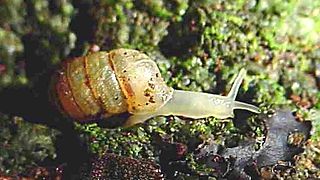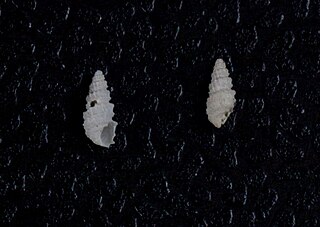
Haminoeidae, commonly known as the haminoeid bubble snail family, is a taxonomic family of sea snails, marine opisthobranch gastropod mollusks in the superfamily Haminoeoidea.

Muricidae is a large and varied taxonomic family of small to large predatory sea snails, marine gastropod mollusks, commonly known as murex snails or rock snails. With about 1,600 living species, the Muricidae represent almost 10% of the Neogastropoda. Additionally, 1,200 fossil species have been recognized. Numerous subfamilies are recognized, although experts disagree about the subfamily divisions and the definitions of the genera. Many muricids have unusual shells which are considered attractive by shell collectors and by interior designers.

Conoidea is a superfamily of predatory sea snails, marine gastropod mollusks within the suborder Hypsogastropoda. This superfamily is a very large group of marine mollusks, estimated at about 340 recent valid genera and subgenera, and considered by one authority to contain 4,000 named living species.

Calliostomatidae is a family of sea snails within the superfamily Trochoidea and the clade Vetigastropoda.

Planorbidae, common name the ramshorn snails or ram's horn snails, is a family of air-breathing freshwater snails, aquatic pulmonate gastropod molluscs. Unlike most molluscs, the blood of ram's horn snails contains iron-based hemoglobin instead of copper-based hemocyanin. As a result, planorbids are able to breathe oxygen more efficiently than other molluscs. The presence of hemoglobin gives the body a reddish colour. This is especially apparent in albino animals.

Nucula is a genus of very small saltwater clams. They are part of the family Nuculidae.

Clausiliidae, also known by their common name the door snails, are a taxonomic family of small, very elongate, mostly left-handed, air-breathing land snails, sinistral terrestrial pulmonate gastropod mollusks.

Streptaxidae is a family of carnivorous air-breathing land snails, terrestrial pulmonate gastropod mollusks in the clade Stylommatophora. Six Streptaxidae subfamilies are accepted in the 2005 taxonomy of the Gastropoda by Bouchet & Rocroi.

Thiaridae, common name thiarids or trumpet snails, is a family of tropical freshwater snails with an operculum, aquatic gastropod mollusks in the superfamily Cerithioidea.

The Columbellidae, the dove snails or dove shells, are a family of minute to small sea snails, marine gastropod mollusks in the order Neogastropoda.

Turbinellidae are a family of sea snails, marine gastropod mollusks in the clade Neogastropoda. Members of this family are predators.

Chrysallida is a speciose genus of minute sea snails, pyramidellid gastropod mollusks or micromollusks in the family Pyramidellidae within the tribe Chrysallidini.

Anatoma is a genus of minute marine gastropod molluscs or micromolluscs in the family Anatomidae, found in Europe, Australia and New Zealand.

Oenopota is a genus of sea snails, marine gastropod mollusks in the family Mangeliidae.

Coralliophila is a genus of sea snails, marine gastropod mollusks in the subfamily Coralliophilinae, the coral snails, within the family Muricidae, the murex snails and rock snails.

Eulima is a genus of small, ectoparasitic sea snails, marine gastropod mollusks in the family Eulimidae.
Chemnitzia is a genus of very small sea snails, marine gastropod mollusks in the family Pyramidellidae, the pyrams and their allies.
Ozimops is a genus of molossid bats found in Australia, Indonesia and Papua New Guinea.
Caryocorbula is a genus of saltwater clams belonging to the Corbulidae family, classified as marine bivalve molluscs.: This genus is often referred to as corbula and serracorbula instead of caryocorbula.

Solitudo is an extinct genus of tortoise that was found during the Pliocene and Pleistocene on the Mediterranean islands of Menorca, Malta and Sicily. The genus includes three described species, Solitudo robusta, Solitudo gymnesica and Solitudo sicula as well as a likely fourth, undescribed species from Monte Pellegrino in Sicily. Solitudo sicula, the youngest of the species, died out approximately 12.5 thousand years BP. The largest species, Solitudo gymnesica, has been estimated to have reached a carapace length of 1.1–1.3 m (3.6–4.3 ft).
















